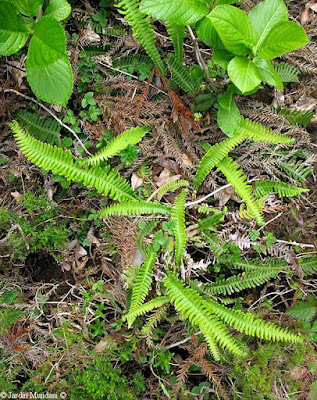Blechnum spicant ssp. spicant is perhaps without exaggerating one of the most rustic, adaptable and resistant ferns of Blechnaceae family. It is able to live as much to total sun as in darkest on the penumbrae, as much in permanently humid zones with the roots flooded throughout the year like in parched grounds that only receive the humidity of the dew contributed in the horizontal rain. Its adaptability even allows to support the polar cold of the south of Iceland. Nevertheless, where better one feels, it is in the pleasant subtropical climate of the Macaronesia. It prefers to grow like rupicolous on vertical walls with its oriented sterile fronds towards the light.
Numerous copies of Blechnum spicant growing in a vertical wall in a clear of a forest of laurisilva near the city of Funchal of the Island of Madeira. In the part superior are seen some vertical fertile fronds in contrast to the sterile fronds that have a horizontal habit. I recommend to extend the photos with a double click to appreciate better the details.
Vigorous sterile fronds of Blechnum spicant photographed in the Caldeira do Faial of the Archipelago of the Azores. In the part superior of the image are seen some leaves of feral allochthonous Hydrangea macrophylla, vulgarly Hortensia call.
Under the leafy treetops of the trees of laurisilva of the Vueltas de Taganana in the heat of Rural Park of Anaga of the Tenerife Island in an atmosphere of intense shadow grows these specimens of Blechnum spicant. The photography was taken with flash in the middle of the month of May.
Blechnum spicant has an ample distribution. Besides the Macaronesia, with the exception of the Cape Verde Islands, also it lives in Europe, Iceland, north of Africa, Smaller Asia and the Caucasus.
It displays two varieties: the Blechnum spicant subsp. spicant var. spicant has very different the fertile and sterile fronds, turgid with pinnae separated and the other pendular with pinnae very together, whereas the Blechnum spicant subsp. spicant var. homophyllum has all the turgid fronds with little differences between fertile and sterile. Pinnae of the fertile fronds, in addition, is less separated than in the variety spicant.
The variety spicant is most abundant and more widely distributed, whereas the variety homophyllum is much more little and it only lives in Galicia and Portugal.
Sterile fronds photographed in the Island of Faial of Azores Archipelago, appearing in the heat of month of May with the increase of the temperatures of the spring.
Beam of a sterile frond with pinnae without petiole inserted directly in rachis. In the fertile fronds pinnae are petiolate. The fronds of the Blechnum spicant are very coriaceous and scraping to the tact. They seem of plastic. The lamina is oblong-lanceolate wider in its central part.
Underside of a sterile fronde with a very prominent rachis. Pinnae have slightly oblique parallel veins to each side of the central nerve that seem immature sori.
Blechnum spicant subsp. spicant var. spicant in May at the time of its maximum splendor with the vigorous turgid fertile fronds and the rosette of horizontal sterile fronds in the lower. Its beauty can be appreciated better extending the photo, that was taken in May in the Natural Park of Madeira.
Fertile fronds of the previous fern close-up views. It calls the attention the intense red blood color of the petiole and rachis. Unlike the sterile fronds, the fertile ones have pinnae very separated and petilate.
Detail of the petiole and rachis of the fertile fronds with its beautiful red color. The sterile fronds have a much more short petiole of green color.
Beam of a fertile frond of Blechnum spicant subsp. spicant var. spicant. It is appraised the stamp of the sori that are in its underside and the denticular edge of pinnae.
Underside of the previous frond with the sori initiating the maturation. The sporangia like black small balls are seen under indusium on the verge of initiating the dispersion of spores.
Sori slightly more mature than those of the previous photo. They are distributed in two very together parallel rows following the central nerve of pinna. Each sorus is covered by a white indusium good developed. Frequently the sori are confluent forming continuous cenosori. The spiculated edge of pinnae with small denticles is appraised. The detail of the insertion of pinnae in rachis with a small petiole is also seen. In Doodia caudata , another very similar Blechnaceae, pinnae of the fertile fronds does not have petiole and they are inserted directly in rachis with an ample base of insertion. (To see the article of Doodia caudata)












No comments:
Post a Comment